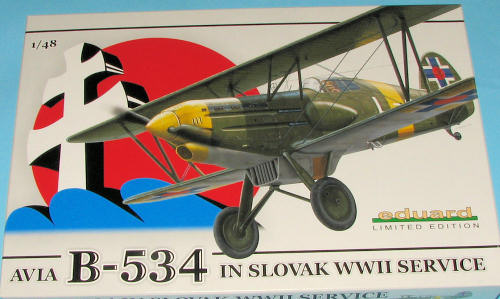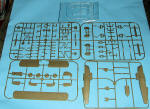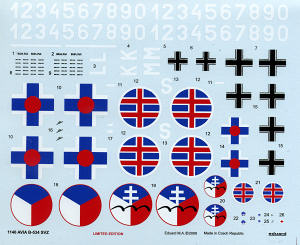
Eduard 1/48 Avia B.534 'Slovak Service'
| KIT #: | 1146 |
| PRICE: | $35.00 MSRP ($29.70 at GreatModels ) |
| DECALS: | Five Options |
| REVIEWER: | Scott Van Aken |
| NOTES: | Injected Multi-media kit |

| HISTORY |
The B-534 was designed as a single-engine biplane fighter with a license-built Hispano-Suiza inline powerplant, and fixed landing gear. Four 7.92 mm (0.312 in) machine guns were located in the sides of the fuselage, firing through the propeller. The air forces of the 1930s were reluctant to abandon the maneuverability and climb rates of biplanes for the speed of monoplanes, even in the face of new and better technology. The success of the Soviet pilots with biplanes may have contributed to this reluctance; they were known to strip their aircraft of sliding canopies, preferring to have the wind in their faces. Aircraft with two fabric-covered wings and fixed landing gear were also less expensive to manufacture.
The first B-534 prototype flew in late May 1933. More work followed and the first order for the Czechoslovakian Air Force was placed in mid-1934. At that time, the B-534 was well ahead of its contemporaries. The United Kingdom was still dependent on Hawker Furies, with the first Gloster Gladiators being produced at this time. The Soviet Union was placing its hope on its Polikarpov aircraft designs. The United States was still using descendants of the Curtiss Hawk series, with the Seversky P-35 and Curtiss P-36 just about to fly prototypes. First deliveries of the B-534 to the Czechoslovakian air force began in late 1935, and 445 or so had been completed by 1938.
The abrupt partition of Czechoslovakia in 1939 prevented the use of the B-534 in combat by the nation that had produced it. By then, high performance monoplanes such as the German Messerschmitt Bf 109, Hawker Hurricane and Supermarine Spitfire were raising the bar of fighter/interceptor standards. Four sub-types were produced during the B-534's production run, all with mostly minor improvements.
One major variation was introduced in this production run. The B-534 was designed to carry one 20 mm (0.79 in) cannon firing through the nose and only two 7.92 mm (0.312 in) machine guns to the sides. Developmental problems prevented the cannon from ever being used and, desperate to get more aircraft in the air, Avia decided to use a third machine gun in the nose only weeks before the German annexation of Czechoslovakia. Only three machines with this configuration were completed for the Czech air force, and the remaining production block was finished for the Germans.
The aircraft was built in four different series, each slightly different from the previous. This kit is of the last series built, which is distinguished by a fully enclosed canopy.
| THE KIT |
 This
2009 boxing is the most recent of the B.534 issues and is, to my knowledge, the
first of the Series IV aircraft. It is a typical Eduard Limited Edition kit in
that it includes color photo etch frets, canopy masks, and a very nicely done
decal sheet with five options.
This
2009 boxing is the most recent of the B.534 issues and is, to my knowledge, the
first of the Series IV aircraft. It is a typical Eduard Limited Edition kit in
that it includes color photo etch frets, canopy masks, and a very nicely done
decal sheet with five options.
 The
molding on the parts is first rate and I found no flash or sink areas that
are prevalent on some kits. There is little in the way of optional bits
aside fro
The
molding on the parts is first rate and I found no flash or sink areas that
are prevalent on some kits. There is little in the way of optional bits
aside fro m
some p.e. replacements for a few plastic bits. All I found aside from the
canopy was an optional head rest section. The kit also includes an
enameled Slovak lapel pin.
m
some p.e. replacements for a few plastic bits. All I found aside from the
canopy was an optional head rest section. The kit also includes an
enameled Slovak lapel pin.
| CONCLUSIONS |
In all, a very nice kit of an important aircraft and one that got the last biplane air to air victory ever. It is not a difficult build and provides everything you'd need to make an excellent model.
| REFERENCES |
http://en.wikipedia.org/wiki/Avia_B.534
March 2010
You can find this and many other fine kits and accessories at www.greatmodels.com.
If you would like your product reviewed fairly and quickly, please contact me or see other details in the Note to Contributors.